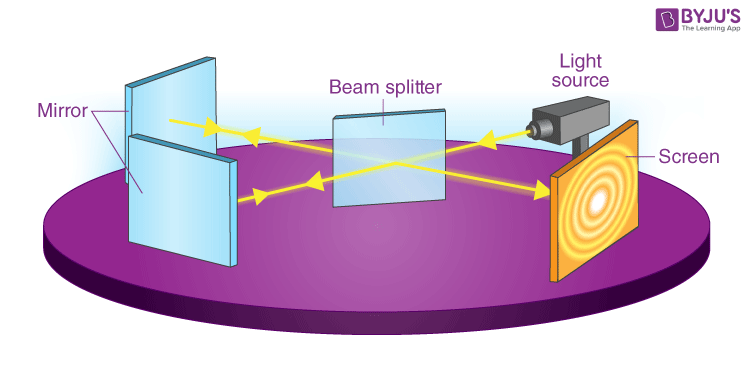We know a medium is absolutely necessary for any transmission in science. The medium of transmission plays an important role in efficient channeling. Waves like sound waves use air for transmission. Then, how is the light transmitted?
Let us know more about the Michelson Morley Experiment in detail to know about light transmission and velocity of the earth.
Michelson Morley Experiment was performed by two eminent scientists Albert A. Michelson and Edward W. Morley in the year 1887 to explain and demonstrate the presence of luminiferous ether.
What Is Luminiferous Ether or Aether?
Luminiferous Ether is the theoretical substance that acts as the medium for the transmission of electromagnetic waves like light rays and X-rays. Ether was assumed to be a transmission medium for the propagation of light.
Luminiferous ether was believed to be a theoretical medium in the 19th century. These substances were assumed to be frictionless, weightless and transparent substances. When the special theory of relativity was developed, the concept of luminiferous ether lost significance gradually.
Michelson Morley Experiment compared the speed of light in perpendicular directions in an attempt to detect the relative motion of matter through the stationary luminiferous aether. But this experiment yielded no results to prove a significant difference between the speed of light in the direction of movement through the presumed aether, and the speed at right angles.
Michelson Morley Experiment
The Michelson Morley Experiment was one of the failed experiments that stands as proof against the existence of the luminiferous ether concept.
Michelson and Morley tried to explain that Earth moved around the sun on its orbit, and the flow of substances like ether across the Earth’s surface could produce a detectable “ether wind”.
They tried to demonstrate the concept that the speed of the light would depend on the magnitude of the ether wind and on the direction of the beam with respect to it when the light is emitted from a source on Earth. Ether was assumed to be stationary. The idea of the experiment was to measure the speed of light in different directions in order to measure the speed of the ether relative to Earth, thus establishing its existence.
Interferometer
To measure the velocity of the Earth with the help of ether and to measure the changing pattern of the light, Albert Michelson developed a device called an interferometer.
The interferometer features the following components
- beam splitter
- beam splitter reference mirror
- coherent light source
- movable mirror
- screen
Pictorial representation of the interferometer is as shown in the figure below.

The interferometer features a half-transparent mirror that is oriented at an angle of 45°. This mirror is used to divide the light beam into two equal parts. One part of the divided beam is transmitted towards a fixed mirror and part of the divided beam is reflected in a movable mirror. The half-transparent mirror has the same effect on the returning beams, splitting them into two beams. Thus, when two diminished light beams reach the screen, a constructive and destructive wave interference pattern is observed based on the length of the arms of the device.
The speed of light was measured in the experiment by analyzing the interference fringes pattern that resulted when the light had passed through the two perpendicular arms of the interferometer. Michelson and Morley observed that light traveled faster along an arm which was oriented in the same direction as the ether. The light traveled at a slower pace in the arm oriented in the opposite direction.
As shown in the figure above, the interferometer featured perpendicular arms. The split light would travel at the same speed in both arms and therefore arrive simultaneously at the screen if the instrument were motionless with respect to the ether.
When the orientation of the interferometer is changed, the crests and troughs of the light waves produced in the two arms would interfere slightly out of synchronization.
The two scientists Michelson and Morley were expecting light to have different speeds when they travel in different directions, but they found no significantly distinguishing fringes that specified a different speed in any orientation or at any position of the Earth.
Lorentz in 1895, concluded that the Michelson Morley experiment produced the null result. Einstein wrote that If the Michelson–Morley experiment had not brought us into serious embarrassment, no one would have regarded the relativity theory as a (halfway) redemption.
When the Michelson Morley experiment was performed with increasing sophistication, the existence of ether and velocity of earth could not be proved.
Stay tuned with BYJU’S for more such interesting articles. Also, register to “BYJU’S – The Learning App” for loads of interactive, engaging Physics-related videos and an unlimited academic assist.
Related links
| Related links | |
| Fermat’s Principle | Dirac Equation |
| Law of conservation of mass | Sound wave propagation |
Frequently Asked Questions on Michelson Morley Experiment
Name the device used in Michelson Morley Experiment.
Interferometer.
What is an interferometer?
It is a device used to measure the changing pattern of the light.
What is Luminiferous Ether?
It is the theoretical substance that acts as the medium for the transmission of electromagnetic waves.
Name the scientists who performed the experiment.
Albert A. Michelson and Edward W. Morley.
Which theory superseded the Michelson Morley Experiment?
Special theory of relativity.
Thank you for providing such type of articles.